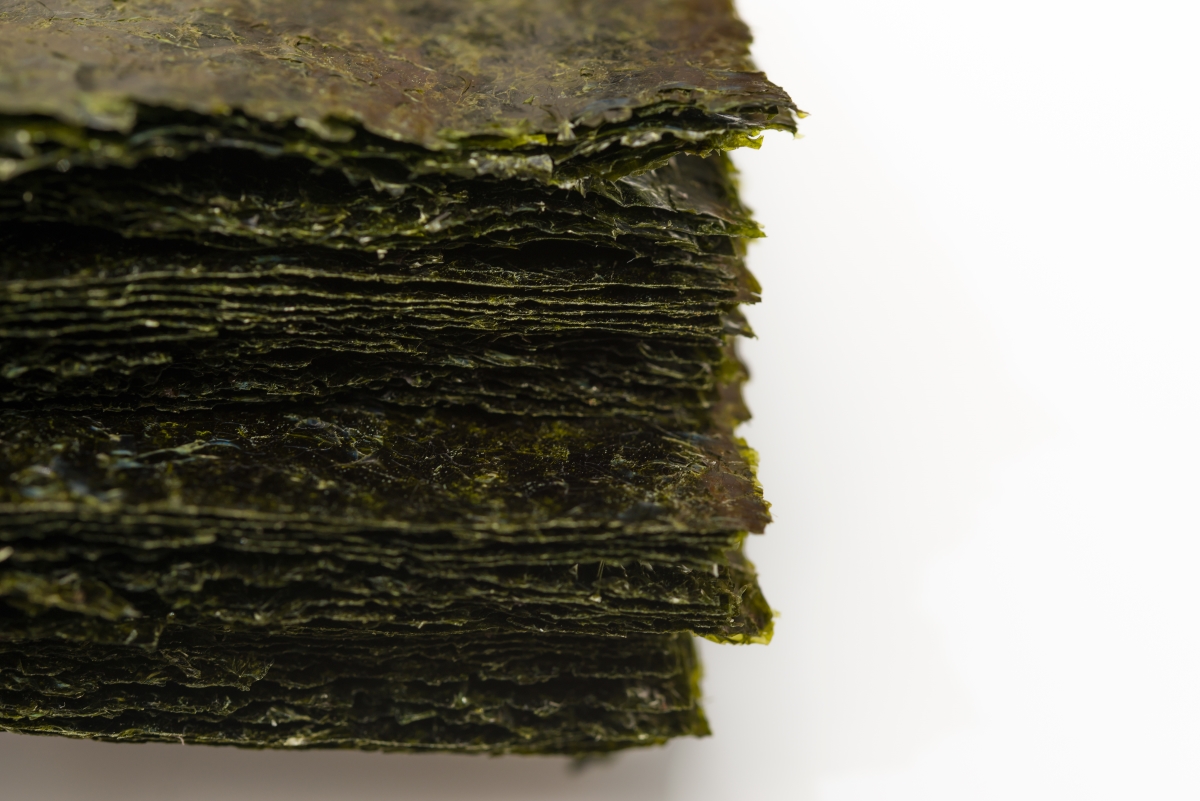Nori (dried laver seaweed) is an essential ingredient of Japanese food. It appears almost daily at the dinner table in the form of Onigiri(rice balls), Maki sushi(sushi rolls), and seasoned powder sprinkled over rice. Dubbed the “sea vegetable,” nori seaweed is a healthy food containing vitamins, minerals, dietary fiber, iron, calcium, and many other nutrients.
Contents:
- Story of Nori Seaweed
- Nori in Japan
- How Nori Seaweed is Produced
- Simple Questions About Nori
- How to cook Nori?
- Lettuce and Nori Salad Recipe
- Roasted Nori Soup Recipe
- Potato and Nori Tempura Recipe
- Spinach and Nori Butter Saute Recipe
Story of Nori Seaweed
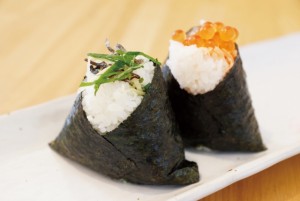 When we examine the history of nori, we find in the Taiho Code (ancient Japanese law) that approximately 30 types of seaweed were presented to the Imperial Court as taxes in kind (cho) in 710 CE. Among the various types of seaweed, nori was considered a delicacy. Currently, nori is produced by seaweed farming, which became popular during the Edo period. All Japanese know nori, but not many of us understand how it’s produced. So, we visited a U.S. nori factory that specializes in traditional nori making and learned many interesting stories.
When we examine the history of nori, we find in the Taiho Code (ancient Japanese law) that approximately 30 types of seaweed were presented to the Imperial Court as taxes in kind (cho) in 710 CE. Among the various types of seaweed, nori was considered a delicacy. Currently, nori is produced by seaweed farming, which became popular during the Edo period. All Japanese know nori, but not many of us understand how it’s produced. So, we visited a U.S. nori factory that specializes in traditional nori making and learned many interesting stories.
Nori in Japan
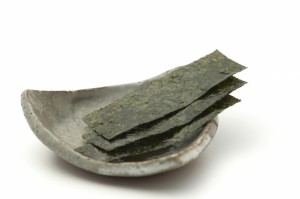 Nori is farmed in Pacific coastal regions, particularly in the Setouchi and Kyushu regions of Japan. Total production of nori amounts to approximately 8 billion sheets a year. Nori is a black sheet of dried laver characterized by its crispness and seaweed flavor. It’s frequently used in Japanese food. Nori is available throughout the year, but the nori harvesting period is from November to March. This is when nori is “in season.” The nori harvested in December is called “shin-nori (new seaweed)” and is characterized by its softness and rich aroma.
Nori is farmed in Pacific coastal regions, particularly in the Setouchi and Kyushu regions of Japan. Total production of nori amounts to approximately 8 billion sheets a year. Nori is a black sheet of dried laver characterized by its crispness and seaweed flavor. It’s frequently used in Japanese food. Nori is available throughout the year, but the nori harvesting period is from November to March. This is when nori is “in season.” The nori harvested in December is called “shin-nori (new seaweed)” and is characterized by its softness and rich aroma.
How Nori Seaweed is Produced
In the Edo period, when nori farming began, farmers didn’t understand the life cycle of their product and depended solely on the experience and sixth sense of fishermen. Accordingly, production was unstable. In the Showa period, Dr. Kathleen Drew-Baker in the U.K. uncovered the life cycle of nori and contributed to the development of reliable nori farming. As time went by, nori production became automated and is today a stable farming business.
Primary Processes
- Carpospores are released from nori harvested during the previous year.
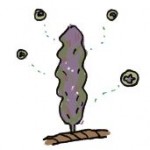 These carpospores are attached to oyster shells and allowed to germinate.
These carpospores are attached to oyster shells and allowed to germinate.- Carpospores then reach the filiform state and grow by dissolving calcareous material. As a result, the oyster shell becomes darker in color.
- Conchospores are produced within filiforms.
- These start splitting as the water temperature drops. Eventually the spores are released, and attach to nets. (This is called seeding.)
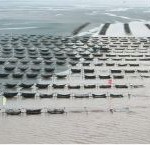 Buds (seedlings) of nori are grown. Post farming or float faming is used, depending on the shape of the beach. Post farming: This method is used on a shallow beach, where the Ariake-Sea method is used to produce soft nori. Float method: Nets are floated over the sea in the Seto-Inland-Sea method to produce hard nori.
Buds (seedlings) of nori are grown. Post farming or float faming is used, depending on the shape of the beach. Post farming: This method is used on a shallow beach, where the Ariake-Sea method is used to produce soft nori. Float method: Nets are floated over the sea in the Seto-Inland-Sea method to produce hard nori. Nets are spread. As the nori buds grow, the stack of 25 to 30 nets is gradually spread into reduced stacks of 20 nets, 15 nets, 10 nets, 5 nets, and so on, and eventually a series of single nets cover the surface of the water where the nori will be grown.
Nets are spread. As the nori buds grow, the stack of 25 to 30 nets is gradually spread into reduced stacks of 20 nets, 15 nets, 10 nets, 5 nets, and so on, and eventually a series of single nets cover the surface of the water where the nori will be grown.- Harvesting
Once the nets are spread, nori grows to about 8 inches in size in half a month or so, and the harvesting period begins. Newly harvested nori commands a high value as Akime Hatsutsumi (the first harvest of the season). Generally, nori becomes harder in the second harvest, third harvest and so on. 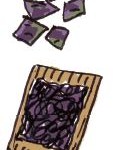 Landed nori is placed in an agitation tank, washed in fresh water, and placed in a machine to remove any foreign matter.
Landed nori is placed in an agitation tank, washed in fresh water, and placed in a machine to remove any foreign matter.- The nori is thinly sliced and adjusted to the proper concentration with water, and then poured onto a nori-sudare (bamboo sheet) for shaping (into a size of 7.5 x 8.25 inches). The shaped nori is dewatered and dried, and then it’s checked again by a foreign-matter detector. In recent years the entire process, from harvesting to drying, has become automated.
- Nori is inspected and sorted into different grades.
Secondary processes
- Wholesalers buy nori at auction. They then bake the nori carefully sheet by sheet on a factory line.
- The baked nori sheets are processed according to the type of the final product and are then packaged. That nori eventually appears on our dinner tables.
Simple Questions About Nori
Q: Nori varies significantly in price, depending on the type. How are the grades determined?
A: Nori is classified into about 40 grades by professional inspectors based on the color, flavor, taste and shape, according to the harvesting period. In general, it is said that nori harvested earlier is softer, and that a year with many rainy days produces better nori.
Q: Does nori go bad? What are the visible signs?
A: Basically, nori doesn’t go bad, but you shouldn’t eat nori if it’s purple in color or, has an odd smell or taste. You can boil down old nori with soy sauce. (Recipe: Tear the nori into pieces, mix in soy sauce and sake at a ratio of 4:1, and boil until the proper consistency is achieved.)
Q: How does one keep/store nori?
A: You don’t want nori to become soggy, so be sure to put it in a sealable plastic bag with a zipper, etc., remove air, and keep it in the refrigerator. This way, nori will be kept in a good shape for a year or so. Of course, it is recommended that you eat nori as soon as possible once it’s unpacked.
Q: Should we use different types of nori for different recipes?
A: Expensive nori doesn’t necessarily taste better. For example, you should use soft nori harvested early for hand-rolled sushi and rice balls, which are eaten quickly. For sushi rolls and rice balls in lunch boxes that aren’t eaten immediately, or for ramen noodle condiments of, etc., harder nori harvested late is more suitable.
How to cook Nori?
Lettuce and Nori Salad Recipe
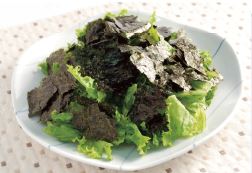
Ingredients (Serves 4)
- 2-3 sheets of yaki nori
- 1 head of lettuce
- Sesame oil and soy sauce for taste
Cooking Directions
- Rinse the lettuce. Dry well and tear it into bite-sized pieces.
- Put the lettuce in a salad bowl and sprinkle the torn nori pieces over it.
- Pour sesame oil over then add soy sauce. (It is critical to pour sesame oil first, otherwise it will be too salty.)
- Before serving add a small amount of vegetable oil and toss it well.
Roasted Nori Soup Recipe
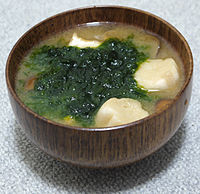
Ingredients (Serves 4)
- 2-3 sheets nori
- 1/2 onion
- 2 strips bacon
- 3 TB corn kernels
- 5 cups water
- 2 T chicken soup granule or consomme granule
- Sesame oil, salt, pepper and soy sauce to taste
- Green onion for garnish
Cooking Directions
- Thinly slice the onion and bacon.
- Boil the water in a sauce pan and resolve the soup granule. Add onion and bacon and cook for a while. Add corn kernels and finely torn nori pieces.
- Adjust the taste with salt, pepper, and soy sauce. Add a small amount of sesame oil for flavor and garnish it with finely chopped green onion.
Potato and Nori Tempura Recipe
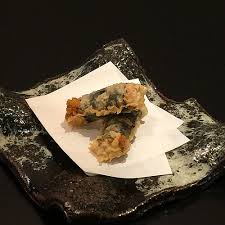
Ingredients (Serves 4)
- 2 sheets of yaki nori
- 4-5 large potatoes
- Salt, oil for frying
Cooking Directions
- Peel and grate the potatoes. Squeeze the water out of the potatoes. (A coffee filter works well for this process)
- Cut the nori sheet into 6 rectangular shapes.
- Spread the grated potato onto the nori sheets. About l/8″ thickness.
- Deep fry the potato and nori sheets for crispy golden brown. Serve warm with salt.
Spinach and Nori Butter Saute Recipe
Ingredients (Serves 2)
- 3-4 nori sheets (torn into pieces)
- 1 bunch spinach
- Butter for sautéing
- Soy sauce, salt and pepper for taste
Cooking Directions
- Clean the spinach (organic is recommended). Cut out the root and cut into bite-size, about 1″ long.
- In a saute pan, melt enough butter and saute the spinach quickly with high heat.
- Add torn nori pieces at one time and cook a little more. Add small amount of soy sauce from the side of the pan and adjust the taste with salt and pepper.
